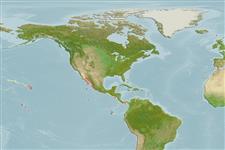Teleostei (teleosts) >
Blenniiformes (Blennies) >
Tripterygiidae (Triplefin blennies) > Tripterygiinae
Etymology: Enneanectes: Greek, ennea = nine times + Greek, nektos = that swimms (Ref. 45335); macrops: Name from Greek 'macros', meaning long, and 'ops' for eye, referring to the comparatively large eye of this species..
Environment: milieu / climate zone / depth range / distribution range
Ecology
Marine; reef-associated; depth range 1 - 12 m (Ref. 93281). Tropical
Eastern Pacific: Mexico.
Size / Weight / Age
Maturity: Lm ? range ? - ? cm
Max length : 4.3 cm SL male/unsexed; (Ref. 93281)
Short description
Identification keys | Morphology | Morphometrics
Dorsal spines (total): 14 - 16; Dorsal soft rays (total): 8 - 10; Anal spines: 2; Anal soft rays: 16 - 18. This thick-bodied species is characterized by the following: large eye; no enlarged scale in pectoral axil; a prominent brown network outlining scales on the lower sides the body; lacking horizontal brown lines (Ref. 93281).
Eggs are hemispherical and covered with numerous sticky threads that anchor them in the algae on the nesting sites (Ref. 240). Larvae are planktonic which occur primarily in shallow, nearshore waters (Ref. 94114).
Life cycle and mating behavior
Maturities | Reproduction | Spawnings | Egg(s) | Fecundities | Larvae
Rosenblatt, R.H., E.C. Miller and P.A. Hastings, 2013. Three new species of the triplefin blennies of the genus Enneanectes (Teleostei, Tripterygiidae) from the tropical eastern Pacific with a key to Pacific species Enneanectes. Zootaxa 3636(2):361-373. (Ref. 93281)
IUCN Red List Status (Ref. 130435)
Threat to humans
Harmless
Human uses
Tools
Special reports
Download XML
Internet sources
Estimates based on models
Preferred temperature (Ref.
123201): 24.6 - 29.1, mean 28.2 °C (based on 109 cells).
Phylogenetic diversity index (Ref.
82804): PD
50 = 0.5001 [Uniqueness, from 0.5 = low to 2.0 = high].
Bayesian length-weight: a=0.00562 (0.00258 - 0.01228), b=3.08 (2.89 - 3.27), in cm total length, based on LWR estimates for this (Sub)family-body shape (Ref.
93245).
Trophic level (Ref.
69278): 2.6 ±0.2 se; based on size and trophs of closest relatives
Resilience (Ref.
120179): High, minimum population doubling time less than 15 months (Preliminary K or Fecundity.).
Fishing Vulnerability (Ref.
59153): Low vulnerability (10 of 100).
